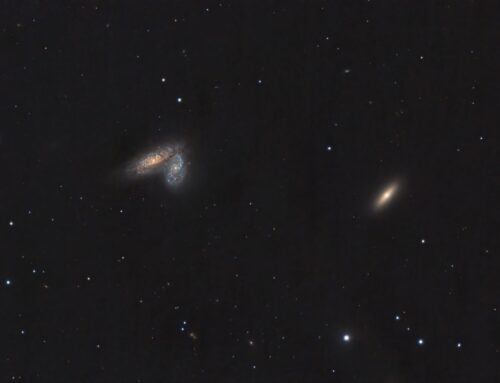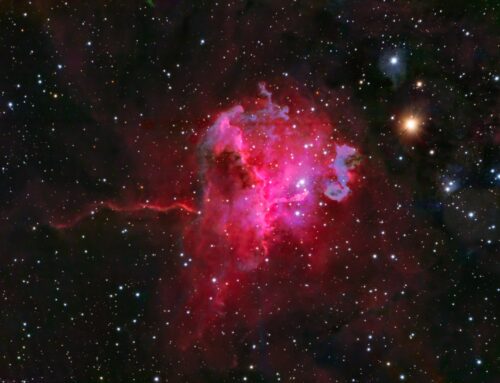Sharpless 232 and 235
 Click image for full size version
Click image for full size version
April 1, 2019
Sh2-232 (centre) and Sh2-235 (lower left) are large, faint regions of Ha-nebulosity in the constellation Auriga. But they aren’t the only objects in the image. The small oval structure just left of centre of Sh2-232 is a planetary nebula, PN G173.5+03.2. Another faint planetary appears as a small yellowish haze around a star just above Sh2-235. I did not find a catalogue number for this object. The estimated distance to Sh2-235 is 5,870 light years. I couldn’t find a distance estimate for Sh2-232, but it is likely similar to Sh2-235, since they appear to be part of the same cloud of hydrogen. For reference, this field is only about 3 degrees (6 moon widths) from the more famous Flaming Star and Tadpole Nebulae, shown in my Clouds of Auriga image.
Tekkies:
Sky-Watcher Esprit 150 f/7 refractor, QHY 16200-A camera, Optolong Ha, R, G and B filters, Paramount MX. Acquisition with TheSkyX unguided. Focused with Optec DirectSync motor and TheSkyX’s @Focus3. Automation with CCDCommander. All pre-processing and processing in PixInsight. Acquired from my SkyShed in Guelph. Moderate moonlight for Ha, minimal moonlight for RGB, average to excellent transparency and fair to average seeing. Data acquired February 2-March 8, 2019.
60x10m Ha and 18x5m R and G and 20x5m B (Total = 14hr40m).
Image scale is about 1.15 arcsec per pixel for this camera/telescope combination.
Data Reduction and Cleanup
The BatchPreProcessing script was used to perform calibration, cosmetic correction and registration of all frames. ImageIntegration was used to make the Ha, R, G and B masters. DynamicCrop was used to crop all the masters identically. DynamicBackgroundExtraction was applied to each master.
RGB
Creation and cleanup: The R, G and B were combined to make an RGB image which was processed with PhotometricColorCalibration.
Linear Noise Reduction: MultiscaleLinearTransform was used to reduce noise in the RGB image. Layer settings for threshold and strength: Layer 1: 5.0 0.8 Layer 2: 3.5, 0.7 Layer 3: 2.5, 0.6 Layer 4: 1.5, 0.2.
Stretching: HistogramTransformation was applied to make a pleasing, bright image.
H-alpha
Deconvolution: A star mask was made to use as a Local Deringing Support Image. A copy of the image was stretched to use as a range mask. Deconvolution was applied (80 iterations, regularized Richardson-Lucy, external PSF made using PSFImage script with 30 stars).
Linear Noise Reduction: MultiscaleLinearTransform was used to reduce noise in the background areas of the Ha image. Layer settings for threshold and strength: Layer 1: 3.5 0.9 Layer 2: 2.5, 0.75 Layer 3: 1.25, 0.6 Layer 4: 0.75, 0.2.
Stretching: HistogramTransformation was applied to the Ha to make a pleasing, bright image. Background intensity was set approximately equal to that of the RGB image.
Combining RGB and Ha
PixelMath was used to add Ha to the RGB, using the following expressions for the R, G and B channels:
R: max($T[0], 1.2*Ha)
G: $T[1]
B: iif($T[0]<Ha, $T[2] + 0.07*Ha, $T[2])
Additional Processing
Nonlinear Noise Reduction: TGVDenoise was applied in L*a*b* mode to reduce noise in the background areas, using a mask to protect low signal areas.
Contrast Enhancement: LocalHistogramEqualization was applied twice. The initial pass used a scale of 54 (max contrast 1.5, strength 0.45, 1 iteration). This was followed by a second pass using a scale of 155 (max contrast 1.5, strength 0.22, 1 iteration).
Sharpening: Using a mask to protect stars, background and dim nebulosity, MultiscaleLinearTransform was used to sharpen Layers 2 and 3 (strengths of 0.1 for both layers).
Final Steps: Background, nebula and star brightness, contrast and saturation were adjusted in several iterations using Curves with masks as required. The DarkStructureEnhance script was applied with 8 layers and a strength of 0.4.






Leave A Comment